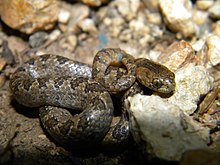
The long-nosed snake is a species of nonvenomous snake in the family Colubridae. The species is endemic to North America. It has two recognized subspecies. The other species in the genus were previously considered subspecies.
Wilfred T. Neill (1922–2001) was an American herpetologist and author. His name survives in the scientific names of the central Florida crowned snake, Tantilla relicta neilli, and a Central American snail-eating snake, Sibon sanniolus neilli.
Emmett Reid Dunn was an American herpetologist noted for his work in Panama and for studies of salamanders in the Eastern United States.
Agkistrodon russeolus, commonly called the Yucatecan cantil, is a venomous pit viper species endemic to the Yucatán Peninsula in Mexico and northern Belize.

Geophis is a genus of snakes in the subfamily Dipsadinae of the family Colubridae of the superfamily Colubroidea. Species in the genus Geophis are commonly referred to as Latin American earth snakes. The genus consists of 53 distinct species.

Senticolis is a genus of nonvenomous snake in the family Colubridae. The genus Senticolis is monotypic, containing the sole species Senticolis triaspis, also known as the green rat snake. The species is endemic to Central America, Mexico, southern Arizona, and southern New Mexico.
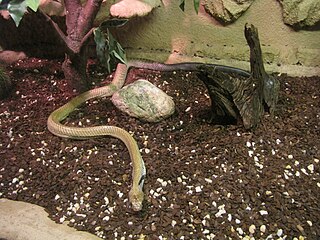
The Middle American indigo snake, also known commonly as the blacktail cribo, is a species of large, nonvenomous, snake in the family Colubridae. The species is native to the southwestern United States, Mexico, Central America, and northern South America. In addition to the nominate subspecies, it has four other recognized subspecies, including D. m. erebennus, commonly known as the Texas indigo snake.
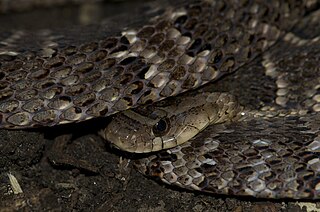
Xenodon rabdocephalus, commonly known as the false fer-de-lance, is a species of mildly venomous rear-fanged snake in the family Colubridae. The species is native to Central America and northern South America. There are two recognized subspecies.
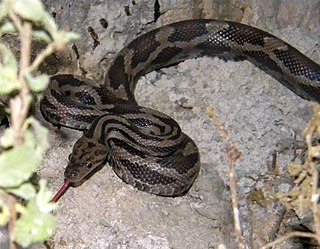
The yellow-red rat snake is a species of snake in the family Colubridae. The species is endemic to Mexico and Central America. Three subspecies are recognized.
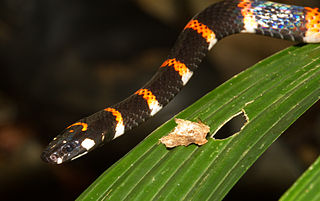
Pliocercus euryzonus, commonly known as Cope's false coral snake, is a species of snake in the subfamily Dipsadinae of the family Colubridae. The species is indigenous to southeastern Central America and northwestern South America. There are two recognized subspecies.

Symphimus is a genus of snakes in the family Colubridae. The genus is endemic to Mexico and Central America.
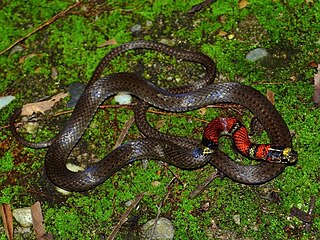
Scaphiodontophis annulatus, commonly known as the Guatemala neckband snake, is a species of snake in the family Colubridae. The species is native to southern Mexico, Central America, and Colombia. There are four recognized subspecies.

Pituophis lineaticollis, commonly known as the Middle American gopher snake or the cincuate bull snake, is a species of nonvenomous snake in the family Colubridae. The species is native to Guatemala and southeastern Mexico. There are two recognized subspecies.

Scincella cherriei, commonly known as the brown forest skink and Cope's brown forest skink, is a species of lizard in the family Scincidae. The species is native to Central America and adjacent southeastern Mexico. Three subspecies are recognized.

Laemanctus serratus, also known commonly as the serrated casquehead iguana, is a species of lizard in the family Corytophanidae. The species is native to southeastern Mexico and Central America. There are two recognized subspecies.

Sceloporus lundelli, also known commonly as Lundell's spiny lizard and la espinosa de Lundell in Mexican Spanish, is a species of lizard in the family Phrynosomatidae. The species is native to the Yucatán Peninsula in Mexico, Belize, and Guatemala. There are two recognized subspecies.

Stenorrhina degenhardtii, also known by its common name Degenhardt's scorpion-eating snake, is a species of snake in the family Colubridae. The species is native to southeastern Mexico, Central America, and northwestern South America. There are three recognized subspecies.

Geophis sartorii, also known commonly as Sartorius' snail-sucker and the terrestrial snail sucker, is a species of snake in the family Colubridae. The species is native to southern North America and Central America. There are two recognized subspecies.
Pliocercus elapoides, also known commonly as the variegated false coral snake, is a species of snake in the family Colubridae. The species is native to southern North America and northern Central America. There are four recognized subspecies.
